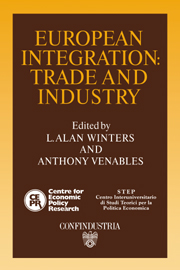Book contents
- Frontmatter
- Contents
- List of figures
- List of tables
- Preface
- Acknowledgements
- List of conference participants
- 1 European integration: trade and industry
- 2 Completing the internal market in the EC: factor demands and comparative advantage
- Discussion
- 3 External effects and Europe's integration
- Discussion
- 4 The quality and production of textiles and clothing and the completion of the internal market
- Discussion
- 5 Competition and imports in the European market
- Discussion
- 6 The structure and determinants of East–West trade: a preliminary analysis of the manufacturing sector
- Discussion
- 7 1992 and EFTA
- Discussion
- 8 Technology policy in the completed European market
- Discussion
- 9 Corporation tax, foreign direct investment and the single market
- Discussion
- 10 Japanese direct manufacturing investment in Europe
- Discussion
- Index
Discussion
Published online by Cambridge University Press: 07 September 2010
- Frontmatter
- Contents
- List of figures
- List of tables
- Preface
- Acknowledgements
- List of conference participants
- 1 European integration: trade and industry
- 2 Completing the internal market in the EC: factor demands and comparative advantage
- Discussion
- 3 External effects and Europe's integration
- Discussion
- 4 The quality and production of textiles and clothing and the completion of the internal market
- Discussion
- 5 Competition and imports in the European market
- Discussion
- 6 The structure and determinants of East–West trade: a preliminary analysis of the manufacturing sector
- Discussion
- 7 1992 and EFTA
- Discussion
- 8 Technology policy in the completed European market
- Discussion
- 9 Corporation tax, foreign direct investment and the single market
- Discussion
- 10 Japanese direct manufacturing investment in Europe
- Discussion
- Index
Summary
This study reconsiders the traditional argument that imports deliver a competitive effect to a national economy by lowering profit margins, and applies it to the creation of the European Internal Market (EIM). From this argument the authors draw the policy implication that lowering trade barriers against imports from the rest of the world could be a powerful tool for promoting competition within the European Community (EC). Hence, internal and external liberalisation in the EC should be pursued jointly to reinforce the effects of the creation of the EIM.
The study first considers the theoretical aspects in some detail and then provides some empirical support; the conclusions the authors draw, however, are somewhat more cautious than their opening statements. Following the structure of the study, I shall first consider the theoretical aspects and then the empirical ones, and suggest additional caution in deriving straightforward policy implications.
The theoretical framework
The main theoretical point in the literature is that there is a negative relationship between domestic price–cost margins and the rate of imports. Such a relationship, however, apart from the Cournot–Nash case, is not always straightforward if one distinguishes between a dominant group of firms and a competitive fringe. If this is the case Geroski and Jacquemin (1981) consider three different possibilities: (a) domestic firms are in the dominant cartel while foreign firms are the competitive fringe; (b) the opposite situation, foreign firms make the cartel while domestic firms compose the competitive fringe; (c) a mix of the two possibilities. In case (b) imports do not represent a discipline on domestic firms; indeed not only is the direction of discipline reversed but its extent is ‘inversely associated with import penetration’ (Geroski and Jacquemin, 1981, p. 200).
- Type
- Chapter
- Information
- European IntegrationTrade and Industry, pp. 92 - 95Publisher: Cambridge University PressPrint publication year: 1991



